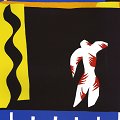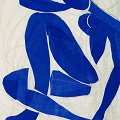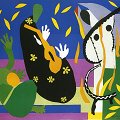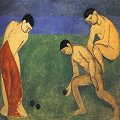Matisse
Paper Cutouts
 First of all, a distinction should be made between the nature of simple
paper cutouts (papier decoupe) and gouache cutouts (gouache
decoupee) followed by a purely terminological choice between "gouache
cutouts" and "gouached-paper cutouts". According to Matisse's daughter,
Marguerite Duthuit, the correct term should be "gouached-paper cutouts",
and she is right, for that expression says it all. It was nevertheless
Pierre Matisse who had the last word, and today the standard French term
is just gouache decoupee. Since gouache can be both a colored
substance and a work produced using that basic substance, it was
understandable that Duthuit held her ground during her many debates with
her brother over "gouached papers" versus "gouaches". There are
nevertheless standard, if less precise, English usage that refers simply
to "paper cutouts", although occasional use is made of the more
accurate term "gouached-paper cutouts" as an indirect tribute to
Duthuit.
First of all, a distinction should be made between the nature of simple
paper cutouts (papier decoupe) and gouache cutouts (gouache
decoupee) followed by a purely terminological choice between "gouache
cutouts" and "gouached-paper cutouts". According to Matisse's daughter,
Marguerite Duthuit, the correct term should be "gouached-paper cutouts",
and she is right, for that expression says it all. It was nevertheless
Pierre Matisse who had the last word, and today the standard French term
is just gouache decoupee. Since gouache can be both a colored
substance and a work produced using that basic substance, it was
understandable that Duthuit held her ground during her many debates with
her brother over "gouached papers" versus "gouaches". There are
nevertheless standard, if less precise, English usage that refers simply
to "paper cutouts", although occasional use is made of the more
accurate term "gouached-paper cutouts" as an indirect tribute to
Duthuit.
What became involved was no longer simply cutting plain "paper". Matisse would take high-quality paper and then seek to develop just the right shade of color in gouache, which a studio assistant subsequently applied to the paper. Only then did the artist cut out the elements that would compose the work, first assembling them in a provisional manner, then definitively. Each shade and each cut of the gouached paper therefore represents a specific creative act.
 The full term "gouached-paper cutout" suggests the difference in
material and visual effect that may exist between ordinary paper cutouts
and gouache cutouts. Gouache is a water-based paint, like watercolor, but
whereas watercolor technique focuses on the transparency of colors,
gouache is opaque. It can therefore be applied in multiple layers of the
same hue in order to reinforce visual intensity. After having prepared the
gouached paper-the raw material-the "painter" could then elaborate the
various elements of his composition. Each one was a fragment of colored
surface that a stroke of the scissors would assert with greater
incisiveness than the stroke of a brush. The new technical approach
dictated by this material and this medium meant that Matisse worked more
like a sculptor who carves directly into the material. Cutting with
scissors rules out all hesitation or revision of what has been
eliminated.
The full term "gouached-paper cutout" suggests the difference in
material and visual effect that may exist between ordinary paper cutouts
and gouache cutouts. Gouache is a water-based paint, like watercolor, but
whereas watercolor technique focuses on the transparency of colors,
gouache is opaque. It can therefore be applied in multiple layers of the
same hue in order to reinforce visual intensity. After having prepared the
gouached paper-the raw material-the "painter" could then elaborate the
various elements of his composition. Each one was a fragment of colored
surface that a stroke of the scissors would assert with greater
incisiveness than the stroke of a brush. The new technical approach
dictated by this material and this medium meant that Matisse worked more
like a sculptor who carves directly into the material. Cutting with
scissors rules out all hesitation or revision of what has been
eliminated.
In preparation for a major exhibition planned for Tokyo from March 3 to June 6, 1951, Matisse was interviewed by a Japanese artist, philosopher, and poet named Riichiro Kawzhima. On meeting Kawzhima, Matisse realized that everything he told his interviewer would be understood in all its subtlety and depth. The catalogue of the show included a foreword by Matisse, a text by Asano, and an article by Kawzhima titled "Words from Matisse". In reference to his paper cutouts, Matisse stated, "I cut paper, but I'm drawing with the scissors. The drawings I obtain by cutting paper are, in a sense, an abstraction. That is why they aren't limited to one thing or one meaning, they seem to vary infinitely depending on who is looking at them".
 Matisse thought he had attained a transcendence or sublimation of color
through the synthesis of forms suggested by incised outlines. Thus from
late winter 1943 to the following autumn he threw himself body and soul
into the visual explorations that would culminate in a commission -
withdrawn in late 1943 or early 1944 - from friend and publisher Andre
Teriade for a publication that was ultimately titled Jazz. The
album would not see the light of day until 1947; it required not only
obstinacy on the part of Matisse to obtain the effects he sought, but also
help from Teriade to overcome the technical difficulties of the
undertaking. The result was a truly exceptional publication. The
elaboration of twenty gouached-paper cutouts with a view to facsimile
reproduction was in full accord with Matisse's enthusiasms of the moment.
Specific titles were given to each composition, and it was only much later
that Matisse dubbed the whole set Jazz thereby alluding to the
similarity between that music, with its strident harmonies and chords, and
the equal stridency and sensitivity of Matisse's colors.
Matisse thought he had attained a transcendence or sublimation of color
through the synthesis of forms suggested by incised outlines. Thus from
late winter 1943 to the following autumn he threw himself body and soul
into the visual explorations that would culminate in a commission -
withdrawn in late 1943 or early 1944 - from friend and publisher Andre
Teriade for a publication that was ultimately titled Jazz. The
album would not see the light of day until 1947; it required not only
obstinacy on the part of Matisse to obtain the effects he sought, but also
help from Teriade to overcome the technical difficulties of the
undertaking. The result was a truly exceptional publication. The
elaboration of twenty gouached-paper cutouts with a view to facsimile
reproduction was in full accord with Matisse's enthusiasms of the moment.
Specific titles were given to each composition, and it was only much later
that Matisse dubbed the whole set Jazz thereby alluding to the
similarity between that music, with its strident harmonies and chords, and
the equal stridency and sensitivity of Matisse's colors.
For an exhibition of drawings and paper cutouts held in Stuttgart in 1993-94, Lydia Delectorskaya recounted the difficulties that had arisen during the production of Jazz, and the variety of successive presentations initially envisaged for the work. Matisse asked, for example, that colors be reproduced using the pochoir (or hand-stenciling) technique, which would prevent any subtleties from being altered by the printing process.
 Three years of experimentation at the printing stage did not dampen the
creative power and joy that Matisse displayed in all the paper cutouts
produced over that long period. Nor did it alter his production methods.
He always devoted his afternoons "to making new combinations of colors",
and the walls of his room were "full of cutouts". Furthermore,
Delectorskaya records that he "was determined to show some twenty paper
cutouts at the exhibition of his recent work at the Musee national d'art
moderne, (presenting them) as fully autonomous works of art".
Three years of experimentation at the printing stage did not dampen the
creative power and joy that Matisse displayed in all the paper cutouts
produced over that long period. Nor did it alter his production methods.
He always devoted his afternoons "to making new combinations of colors",
and the walls of his room were "full of cutouts". Furthermore,
Delectorskaya records that he "was determined to show some twenty paper
cutouts at the exhibition of his recent work at the Musee national d'art
moderne, (presenting them) as fully autonomous works of art".
Today it is obvious that these paper cutouts constitute major works in the history of art. Such series as Nus bleus (Blue Nudes) are not only recognized as such but are widely appreciated. In 1962, eight years after the master's death, the French postal service chose to issue two of his Nus bleus as stamps. The two figures, whose choice was sanctioned by the Matisse family, give a good idea of the monumentality of the original paper cutouts. Marcel Billot rightly referred to the "impression of monumentality created by these (gouaches) - a monumentality that seems at odds with the actual size of the book (Jazz)".
Henri Matisse Art

|
|
More
Articles
 Art Encyclopedia A world history of art in articles.
Art Encyclopedia A world history of art in articles.
Modernism
Henri Matisse
Life and work.
The Music. The Dance.
Simply painting and color.
Paper cutouts.
Art
 Art Wallpapers Art image collections for your desktop.
Art Wallpapers Art image collections for your desktop.
Munch Art, $19
(75 pictures)
Malevich Art, $25
(105 pictures)
Modigliani Art, $29
(135 pictures)
Klee Art, $25
(150 pictures)
Miro Art, $35
(150 pictures)
Matisse Art, $29
(180 pictures)
Picasso Art, $29
(175 pictures)
Dali Art, $35
(275 pictures)
Chagall Art, $35
(175 pictures)

